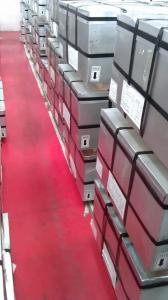Tinplate for food cans and chemical cans
- Loading Port:
- Tianjin
- Payment Terms:
- TT OR LC
- Min Order Qty:
- 50 m.t.
- Supply Capability:
- 4000 m.t./month
OKorder Service Pledge
OKorder Financial Service
You Might Also Like
Prime Quality Tinplate Sheets Details
1.Structure of Description
Electrolytic Tinplate Sheets is one of the metal packing materials, which is widely used for making painting cans ,chemical package cans , electrical cable ,battery and metal printing etc. For caps, there are some customers also need TFS, if you have some demand for TFS,also can contact with us.
2. Main Features
Steady and high quality
Fast shipment
Good experience for export work
For the surface, Plate uniform in thickness,uniform and smooth tin coating, without flaws,rusts,scratch,wave,nick of tin coating etc.



Minumum Order Quantity: 25 MT Loading Port:China Main Port
Annual Capacity: 400,000MT Payment Terms:TT or LC
Product Specifications:
Prime Quality Tinplate Sheets Usage and Applications
Prime Quality Tinplate Sheets Specifications
Standard : GB2520-2000 ,JIS G3303
Steel type : SPCC
Coating : 2.8/2.8
Surface: Bright, Stone ,
Thickness:0.18
Width :600MM~1000MM
Temper : T1~T5
Package: tinplate wrapped completely with an inner cover of plastic or waterproof papers with vorners protected with metal angels.
Applications
Chemicals and painting cans
Dry food cans, such as fancy cans, biscuit cans, milk power cans, tea cans
Liquid food cans, such as edible oil cans, beverage cans, Tomato paste cans
Sea food cans
Crown corks, easy open ends(EOE)
Electrical machinery parts
Bakeware and household kitchen parts
FAQ
A. What is the package of tinplate? (Referred as below)
For sheets, thin plastic film + rust-proof paper + metallic cover + metallic angles+ steel band strips + fumigated wooden pallet.
For coil, thin plastic film + rust proof paper + metallic cover + steel band strips + fumigated wooden pallet
B. The surface of tinplate could you supply?
Stone finish, Bright finish, Matte finish, Silver finish
- Q: How does tinplate contribute to the overall protection of packaged products?
- Tinplate contributes to the overall protection of packaged products by providing a durable and corrosion-resistant barrier. This helps to prevent contamination, spoilage, and damage from external factors such as moisture, oxygen, light, and microorganisms. Tinplate also offers excellent heat resistance, ensuring the integrity and safety of the packaged products during transportation, storage, and usage.
- Q: Can tinplate be used for packaging industrial products?
- Yes, tinplate can be used for packaging industrial products. Tinplate is a commonly used material for packaging due to its sturdiness, corrosion resistance, and ability to be easily formed into various shapes and sizes. It provides excellent protection for industrial products during storage and transportation.
- Q: What are the common thicknesses of tinplate?
- The common thicknesses of tinplate range from 0.13mm to 0.49mm, with the most commonly used thicknesses being 0.18mm, 0.20mm, and 0.23mm.
- Q: Can tinplate be used for paint cans?
- Yes, tinplate can be used for paint cans. Tinplate is a commonly used material for manufacturing paint cans due to its durability, corrosion resistance, and ability to preserve the quality of the paint inside. It also provides a smooth surface for labeling and branding purposes.
- Q: How does tinplate contribute to the reduction of carbon emissions?
- Tinplate contributes to the reduction of carbon emissions through its sustainable production process and recyclability. Compared to other packaging materials, tinplate has a low carbon footprint as it requires less energy and releases fewer greenhouse gases during manufacturing. Additionally, tinplate is a highly recyclable material, allowing for the efficient reuse of resources and reducing the need for new production. By promoting the use of tinplate, we can minimize carbon emissions and work towards a more environmentally friendly packaging solution.
- Q: Can tinplate be used for non-food products?
- Yes, tinplate can be used for non-food products. Tinplate is a versatile material commonly used in various industries such as packaging, construction, automotive, and electronics. It is durable, corrosion-resistant, and has excellent formability, making it suitable for a wide range of non-food applications like cans, containers, aerosol cans, electrical components, and decorative items.
- Q: Can tinplate be used for jewelry and fashion accessories?
- Yes, tinplate can be used for jewelry and fashion accessories. Tinplate is a versatile material that can be shaped and molded into various designs, making it suitable for creating fashionable and trendy accessories. Additionally, tinplate can be coated with different finishes such as gold or silver, further enhancing its appeal for use in jewelry and fashion accessories.
- Q: What are the main trends in tinplate recycling?
- The main trends in tinplate recycling include increased awareness and implementation of recycling programs, advancements in technology for efficient separation and processing of tinplate, and the growing demand for sustainable packaging solutions. Additionally, there has been a shift towards closed-loop recycling systems, where tinplate waste is recycled and used to produce new tinplate products, reducing the need for virgin materials.
- Q: What are the common surface coatings for tinplate?
- The common surface coatings for tinplate include lacquer, enamel, organic coatings, and tin-free steel coatings.
- Q: What are the main quality standards for tinplate?
- The main quality standards for tinplate include the thickness and uniformity of the tin coating, adhesion strength between the tin and base metal, absence of surface defects such as scratches or dents, and compliance with specific mechanical and chemical properties required for different applications.
Send your message to us
Tinplate for food cans and chemical cans
- Loading Port:
- Tianjin
- Payment Terms:
- TT OR LC
- Min Order Qty:
- 50 m.t.
- Supply Capability:
- 4000 m.t./month
OKorder Service Pledge
OKorder Financial Service
Similar products
Hot products
Hot Searches
Related keywords






























